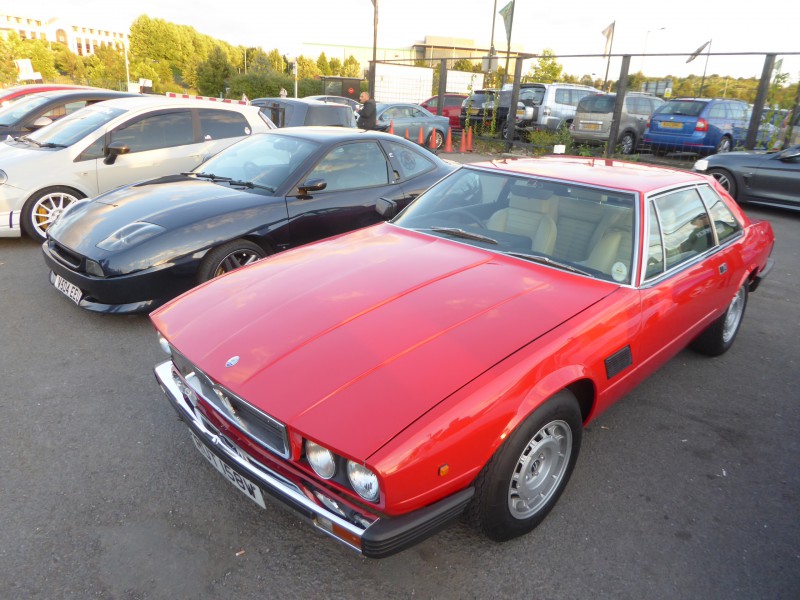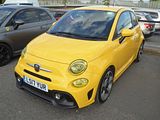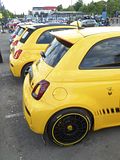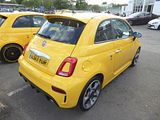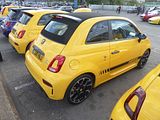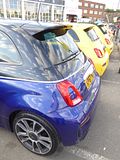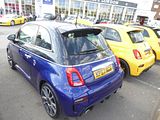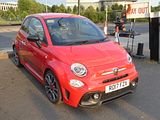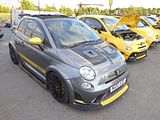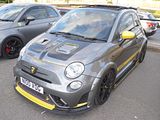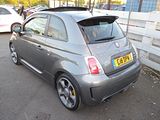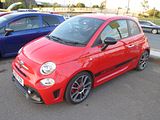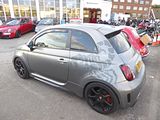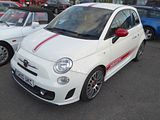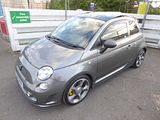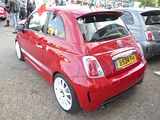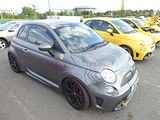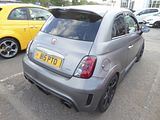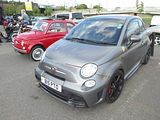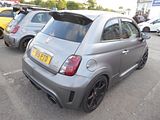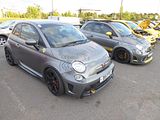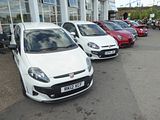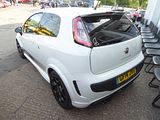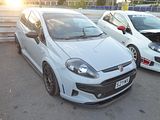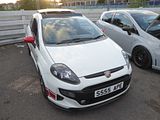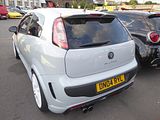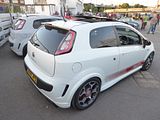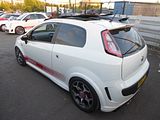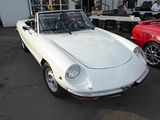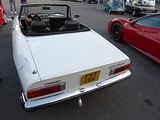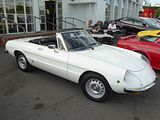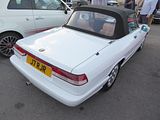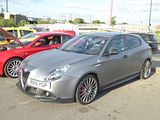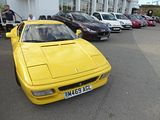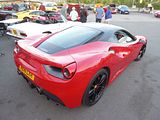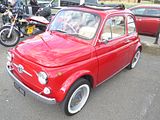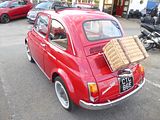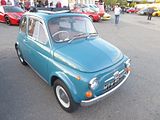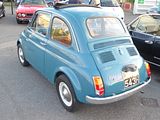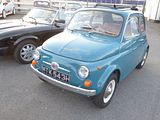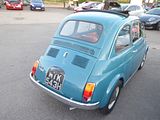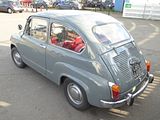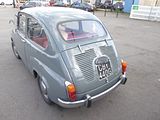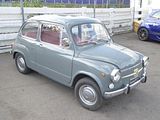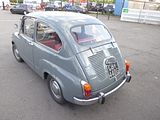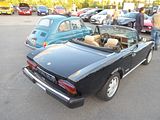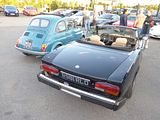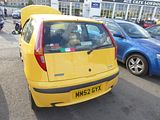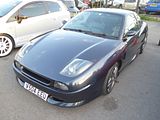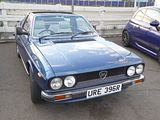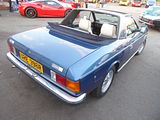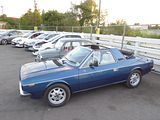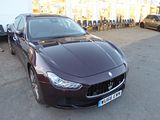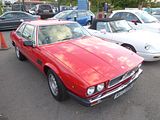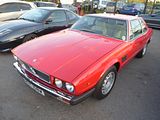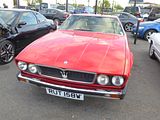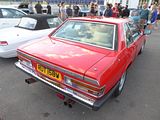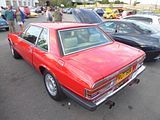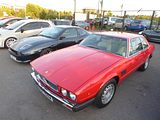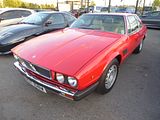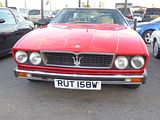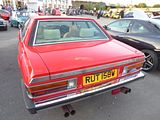Having enjoyed my evening at the Ace Cafe in May, for Italian Night, which combined a good turn out of cars, with a mix of the familiar and the rare, some pleasant evening sunshine, and some good company among a number of Abarth-owning friends, when the calendar had advanced a month forward, I was optimistic of recreating something similar in June. I’ve learned in the past that the weather is important, and that a wet afternoon even if its predicted to dry out completely by evening time can be a massive deterrent, but on this occasion, there looked to be little threat from the skies above, with the promise of dry if not particularly sunny skies. The reality turned out to be better than that, and indeed the setting sun would turn out to be the photographer’s challenge until it was low enough in the sky. Early evening traffic seemed more of an issue, and my plans to arrive early were thwarted by a very slow crawl along a couple of miles of the M40 following an accident, and then just solid and slow moving lines all the way from the inside of the M25 to the Hanger Lane gyratory, but eventually I arrived on site, not long after 6pm, to find only a handful of Italian cars, quite a few non Italian ones and a vast array of bikes occupying the forecourt in front of the famous Cafe. The bikes were in the process of making a rather noisy exit, and gradually the non-themed cars were moved elsewhere, and steadily Italian cars arrived, many it seemed also finding the traffic to have made them later than they planned. By 7pm, the perimeter was largely full, and although the central part of the parking was barely needed, with some of the early arrivers making a relatively early departure, there was plenty to look at during the course of what turned out to be another very agreeable evening. Here are those Italian cars from the evening.
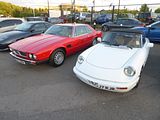

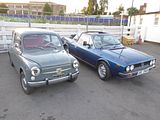
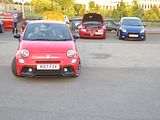
By some margin, Abarth would turn out to be the best represented marque, with around 20 Scorpion badged cars present at some point in the evening, though they were not quite all there at the same time. I know I missed at least one car, as the light bouncing off it would have yielded truly awful photos, and by the time the sun had gone down low enough, the owner decided to leave. Most numerous of the cars were, of course, 500-based models, and most of them were relatively recent cars, and hence badged 595. Among them were the three Modena Yellow cars, all recent acquisitions, that are collectively known in Abarth Owners Club circles as the “Three Bumble Bees”, and these arrived, in convoy, led by Dan Deyong, along with a fourth (and not yellow) model shortly after I did.
There were plenty of others, including some older and very familiar cars were also here, with Paul Hatton’s much loved and now somewhat personalised Pasadoble Red 500 Essesse in pole position by the door, and Ian Payne’s Record Grey 595 Competizione, a Phase 2 car, close by, as well as Nico Vogli’s unique and attention-grabbing car which arrived mid evening.
A little variety was provided when Jerry Rigden arrived in his 695 Biposto. These remain rare, with just 33 registered in the UK, so you are not going to see one very often, even when Abarths are gathered together en masse. First shown at the 2014 Geneva Show, this 2 seater (that’s what Biposto means in Italian) is nothing other than a road legal version of the 695 Assetto Corse Racing car, a vehicle which has its own race series in Europe. Although the car is road legal, it was envisaged that the majority of people who buy one of these cars will use it on the track and quite frequently. So it was conceived accordingly. That means upgrades to all the important bits – engine, brakes, suspension, gearbox – and some fairly drastic measures to save weight which resulted in a car which generates 190 bhp and 199 lb/ft or 250 Nm of torque with a kerb weight of just 997kg. That’s enough to give a 0 – 60 time that is under 6 seconds, and a top speed of 143 mph. Those are supercar figures produced by a city car. There’s more to it than that, though, as the changes that go to make a Biposto are extensive, and they have been well thought through, so this is a long-way from being a hastily conceived or tuned up special. Ignoring the limited edition cars which arrived during 2015, the “regular” Biposto is only offered in Matt Performance Grey paint, and the car is visually distinctive, with a new front bumper, rear diffuser, wider arches, new skirts and bigger roof spoiler. Although the engine is still the same 1.4 T-jet that features in the lesser 500 and 595 cars, it has been reworked here, with a new Garrett turbocharger, larger intercooler, altered fuel rail and an Akrapovic exhaust system. Buyers can choose between the standard five speed gearbox or an optional race-bred dog-ring unit mated to a mechanical limited slip diff. The standard car’s MacPherson strut and torsion beam suspension has been reworked, too, with altered springs, wider tracks adjustable ride height and dampers with more resilient bushings, using Extreme Shox technology shock absorbers. The brakes are upgraded in line with the extra power, featuring 305mm Brembo discs and four pot calipers up front and 240mm discs with single pot calipers at the rear. The wheels are lightened 18″ OZ and attached via a titanium hub, shod with bespoke 215/35 Goodyear tyres. In the interest of weight saving, a number of standard trim items are removed, including the regular door trims, air conditioning, the rear seats and some of the sound deadening material. Even the standard air vents have been changed so they are covered by a simple mesh. In their place is plenty of polished carbon fibre, a titanium strut brace, racing seats and harness, as well as special trim features such as new pedals, tread plates and a race inspired digital display on the dash where the radio usually sits.
There were a couple of Punto Evo cars already parked up when I arrived, both belonging to venue stalwarts, Olaf Svendsen and Steve Miller. Not that long after I arrived, several more turned up, in convoy. All were Punto Evo models, which are the ones you see more often these days, even though there are still similar numbers of the earlier Grande Punto still registered in the UK. They did not outnumber the 500s, but this was the closest ratio of one model to the other that I have seen in quite a while.
ALFA ROMEO
Alfa Romeo was the next most represented marque, with a variety of different models here. Oldest of these were a couple of the long-lived 105 Series Spider. This was the perfect evening for bringing a car like this, roof down, out for a nice trip in the late spring sunshine. Alfa replaced the Giulia-based Spider model with an all-new design which finally made its debut in 1966 together with the Giulia Sprint GT Veloce at an event organised in Gardone Riviera. With its boat tailed styling, it quickly found favour, even before taking a starring role in the film “The Graduate”. The original 1600cc engine was replaced by a more powerful 1750cc unit at the same time as the change was made to the rest of the range, and the car continued like this until 1970, when the first significant change to the exterior styling was introduced on the 1750 Spider Veloce, with the original’s distinctive elongated round tail changed to a more conventional cut-off tail, called the “Kamm tail”, as well as improving the luggage space. Numerous other small changes took place both inside and out, such as a slightly different grille, new doorhandles, a more raked windscreen, top-hinged pedals and improved interior trim. 1971 saw the Spider Veloce get a new, larger powerplant—a 1962 cc, 132 hp unit—and consequently the name was changed from 1750 Spider Veloce to 2000 Spider Veloce. The 1600 Spider restarted production a year later as the Spider 1600 Junior, and was visually identical to the 1300. 1974 saw the introduction of the rare, factory request, Spider-Targa. Based upon the Spider, it featured a Porsche style solid rear window and lift out roof panels, all made out of black GRP type material. Less than 2,000 models of such type were ever made and was the only part solid roof Spider until the introduction of the factory crafted hard top. The 1300 and 2000 cars were modified in 1974 and 1975 respectively to include two small seats behind the front seats, becoming a “two plus two” four seater. The 1300 model was discontinued in 1977. Also, between 1974 and 1976, the early-style stainless-steel bumpers were discontinued and replaced with black, rubber-clad units to meet increasingly stringent North American crash requirements. 4,557 examples of the 1300 Junior were made and 4,848 of the 1600 Junior as well as 16,320 2000 Spider Veloces and 22,059 of 2000 Spider Veloce US version. There were also 4,027 1750 Spider Veloces produced. There was a nice example of the Series 2 car here, the only version which was officially sold new in the UK.
Although demand for the car in Europe dropped in the 1980s, it remained popular in the US, which meant that Alfa not only kept the car in production, but also updated a couple more times. The S4 marked the final major change to the long running Spider when it came out in 1990. Mechanically, the biggest different was the use of Bosch Motronic electronic fuel injection with an electric fan. Externally, the Spider lost its front under-bumper spoiler and the rather ungainly rear boot spoiler of the S3, and picked up 164-style rear lights stretching across the width of the car as well as plastic bumpers the same colour as the car. This also marked the first generation of the car with automatic transmission, as well as on-board diagnostics capabilities. The car had remained in production largely thanks to continued demand in North America, though this market had to wait until 1991 for the changes to appear on their cars. European markets were offered a car with a 1600cc engine and carburettors as well as the 2 litre injected unit. As with the earlier S3, the car was not sold new in the UK by Alfa Romeo, but a number of them were imported at the time, and more have found their way to the UK since. Some have been converted to right hand drive, which makes the car more usable in the UK. Production finally ended in 1993, with an all new model, the 916 Series Spider appearing a year later.
Rather than replacing the 916 Series GTV with a single model, Alfa elected to produce two successors., The more commodious of the two, the GT, was the first to appear, making its debut in March 2003 at the Geneva Motor Show, finally going on sale in early 2004. It was built at the Pomigliano plant, alongside the 147 and 159. The GT was based on the Alfa 156 platform, which was also used for the 147, providing the 2-door coupé with genuine five-passenger capacity. It was styled by Bertone. Most mechanicals were taken directly from the 156/147 using the same double wishbone front suspension and MacPherson rear setup. The interior was derived form the smaller hatchback 147 and shared many common parts. The GT shared the same dash layout and functions, the climate control system as well as having a similar electrical system. Some exterior parts were taken from 147 with the same bonnet, wing mirrors and front wings (from 147 GTA). The engine range included both a 1.8 TS, and 2.0 JTS petrol engine, a 1.9 MultiJet turbodiesel, and a top-of-the-range 240 bhp 3.2 V6 petrol. There were few changes during the GT’s production life. In 2006 Alfa introduced a 1.9 JTD Q2 version with a limited slip differential, and also added a new trim level called Black Line. In 2008 Alfa introduced the cloverleaf model as a limited edition complete with new trim levels, lowered suspension, body kit, 18 inch alloy wheels and was only available in the colours black, Alfa red, or blue. with 1.8 and 2.0 litre petrol engines as well as the 1.9 litre Multijet turbo diesel. The GT was acclaimed for its attractive styling and purposeful good looks, in 2004 being voted the world’s most beautiful coupe in the annual ‘World’s Most Beautiful Automobile’ (L’Automobile più Bella del Mondo) awards. The car sold reasonably well, with 80,832 units being produced before the model was deleted in 2010.
It is quite sobering to realise that the little MiTo has been on sale for 10 years. Whilst sales have been steady rather than spectacular in that time, the smallest Alfa currently made has found plenty of fans and there is now an enthusiastic MiTo Owners Club, so where Italian cars are gathered together, it is quite common to get a whole line of the smallest current Alfa assembled, and indeed there were several of them here on this occasion. Known internally as the Tipo 955, the MiTo (the name allegedly standing for Mi-lano and To-rino, where it was designed and is built, respectively, and a pun on the Italian word for “myth”), the smallest Alfa ever made is a three-door only supermini, which was officially introduced on June 19, 2008, at Castello Sforzesco in Milan,, going on sale a few weeks later, with UK supplies reaching the country after the British Motor Show in 2008. Built on the Fiat Small platform used on the Grande Punto, and also employed by the Opel/Vauxhall Corsa, the MiTo was intended to compete with the MINI and the newer Audi A1. Designed by Centro Stile Alfa Romeo, the design is believed to be inspired by the 8C Competizione. A range of engines has been offered since launch, though sadly the GTA Concept that was shown at the 2009 Geneva Show never made it to production.
The current Giulietta arrived in 2010 as a much awaited replacement for the 147. Spy photos had suggested that the car was going to look very like Fiat’s ill-fated Bravo, but the reality was that it had a style all of its own. A range of very efficient petrol and diesel engines were among the most emissions-efficient in their class at the time, and a 250 bhp Quadrifoglio version at the top of the range made sure there was something for the man who wanted a rapid, but quite subtle hatch. The car has enjoyed reasonable success in the UK, and the car has certainly found favour among Alfa enthusiasts, so it was no surprise to find this model present here, too.
FERRARI
Ferrari models are quite a rare sighting at this event, even in the sunshine, but this time, there were a couple of them to look at. And they certainly did create lots of interested. Older of the duo was a 348 tb, in the less commonly seen colour of yellow. With styling that had a close link to the Testarossa, the 348 was launched, in 1989 as a replacement for the 328 GTB/GTS models. At launch, the 348 series were not that enthusiastically received by the press who found much to complain about. The 348’s styling differed from previous models with straked side air intakes and rectangular taillights resembling the Testarossa. Launched in two models, a coupe badged 348 tb (Trasversale Berlinetta) and targa roofed 348 ts (Targa), these were soon joined by a fully open car, the 348 Spider. All featured a normally aspirated 3.4-litre version of the quad-cam, four-valve-per-cylinder V8 engine. As with its predecessors, the model number was derived from this configuration, with the first two digits being the displacement and the third being the number of cylinders. The engine, which produced 300 hp was mounted longitudinally and coupled to a transverse manual gearbox, like the Mondial t with which the 348 shared many components. This was a significant change for Ferrari, with most previous small Ferraris using a transverse engine with longitudinal transmission. The “T” in the model name 348 tb and ts refers to the transverse position of the gearbox. The 348 was fitted with dual-computer engine management using twin Bosch Motronic ECUs, double-redundant anti-lock brakes, and self-diagnosing air conditioning and heating systems. Late versions (1993 and beyond) have Japanese-made starter motors and Nippondenso power generators to improve reliability, as well as the battery located within the front left fender for better weight distribution. Similar to the Testarossa but departing from the BB 512 and 308/328, the oil and coolant radiators were relocated from the nose to the sides, widening the waist of the car substantially, but making the cabin much easier to cool since hoses routing warm water no longer ran underneath the cabin as in the older front-radiator cars. This also had the side effect of making the doors very wide. The 348 was equipped with a dry-sump oil system to prevent oil starvation at high speeds and during hard cornering. The oil level can only be accurately checked on the dipstick when the motor is running due to this setup. The 348 was fitted with adjustable ride-height suspension and a removable rear sub-frame to speed up the removal of the engine for maintenance. Despite trenchant criticism of the car, especially its handling, 2,895 examples of the 348 tb and 4,230 of the 348 ts were produced.
The more recent model was a 488 GTB, which turned out to belong to a gent who has been many times before, and who I remember bringing of the very first Ferrari F12 Berlinetta cars here, a left hand drive loaner while he was waiting for his own car to arrive. He said that he did not keep that very long, as it proved almost undriveable in British traffic, in so many ways, from its size, to the abrupt way the power would cut in unless you barely touched the throttle. He finds the 488 rather less intimidating. Launched at the 2015 Geneva Show, and now a reasonably common sight on our roads, by Ferrari standards, the 488GTB followed the lead set by the California T in bringing turbocharging into a modern-day, mid-engined V8 Ferrari supercar for the first time. The engine is completely new when compared with its V8 stablemate, not only in components but also in feel and character. It is a twin-turbocharged 3902cc unit whilst that in the California T is 3855cc. In the 488 GTB, it produces 660bhp at 8000rpm and 560lb ft at 3000rpm. Both outputs are significant increases over the normally aspirated 4.5-litre V8 used in the 562 bhp 458 Italia and 597 bhp 458 Speciale, and also greater than the car’s biggest rival, the McLaren 650S. The torque figure of the 488 GTB is such that it also exceeds the 509lb ft at 6000rpm of the normally aspirated V12 used in the range-topping Ferrari F12 Berlinetta. The mighty new engine in the 488 GTB drives the rear wheels through a revised seven-speed dual-clutch automatic gearbox derived from the 458. It features a new ‘Variable Torque Management’ system which, Ferrari says, “unleashes the engine’s massive torque smoothly and powerfully right across the rev range”. The gear ratios are also tuned to “deliver incredibly progressive acceleration when the driver floors the throttle”. The 488 GTB can crack 0-62mph in just 3.0sec, 0-124mph in 8.4sec and reach a top speed of 205mph. Its 0-62mph and 0-124mph times match the McLaren 650S’s, but the Woking car’s top speed is slightly higher at 207mph. The engine also accounts for the ‘488’ element of the car’s name, because each of the engine’s eight cylinders is 488cc in capacity when rounded up. The GTB suffix, standing for Gran Turismo Berlinetta, is a hallmark of previous mid-engined V8 Ferraris such as the 308 GTB. Not only is the new turbo engine more potent than the 4.5-litre V8 from the 458 Italia, but it is also more economical. Combined fuel economy is rated at 24.8mpg, compared with 21.2mpg in the 458 Italia, and CO2 emissions are 260g/km – a 47g/km improvement. Ferrari’s HELE engine stop-start system features on the 488 GTB. Developments on the dynamic side include a second generation of the Side Slip Angle Control system, called SSC2. This allows the driver to oversteer without intruding, unless it detects a loss of control. The SSC2 now controls the active dampers, in addition to the F1-Trac traction control system and E-Diff electronic differential. Ferrari says the result is “more precise and less invasive, providing greater longitudinal acceleration out of corners” and flatter, more stable behaviour during “complex manoeuvres”. Learnings from the Ferrari XX programme have also been incorporated into the 488 GTB, something that Ferrari says allows all drivers and not just professionals, to make the most of its electronic and vehicle control systems. It also claims the 488 GTB is “the most responsive production model there is”, with responses comparable to a track car. The 488 GTB has lapped Ferrari’s Fiorano test track in 1min 23sec – two seconds faster than the 458 Italia, and half a second quicker than the 458 Speciale. The dimensions of the 488 GTB – it is 4568mm in length, 1952mm in width and 1213mm in height – closely match the 458 Italia from which it has evolved. Its dry weight is 1370kg when equipped with lightweight options – 40kg more than the McLaren 650S. The new look, styled at the Ferrari Styling Centre, features several new aerodynamic features that improve downforce and reduce drag. Most notable is the addition of active aerodynamics at the rear through a ‘blown’ rear spoiler, where air is channelled from the base of the glass engine cover under the spoiler. This contributes to the 50% increase in downforce over the 458 Italia. Also new is a double front spoiler, an aerodynamic underbody, a large air intake at the front that references the 308 GTB, a diffuser with active flaps, new positioning for the exhaust flaps and new-look lights. The interior has been redesigned to be made more usable, including new switchgear, air vents and instrument panel. The multi-function steering wheel remains, while the infotainment system gets a new interface and graphics. The Spider followed the closed coupe model six months later, and just as with the 458, this is now the bigger seller of the pair.
FIAT
Always popular whenever they appear are examples of the Nuova 500, Dante Giacosa’s much loved tiny city car, and there were a couple of these present during the evening. As always, there were lots of people declaring just how cute and appealing this tiny cars are. Known as project 110, the brief for the Nuova 500 was to create a micro-car that would not only carry on the tradition of the earlier Topolino, but which would also take sales away from the ever popular Lambretta and Vespa scooters of the day. It clearly needed to be smaller than the 600 which had been released with a conventional 4 cylinder engine. Not an easy task, but development started in 1953 and by August 1954, two designs were ready to be shown to Fiat management. They selected one, and serious development began. At first the car was referred to as the 400, as it was going to have a 400cc engine, but it was soon realised that this was just too small, so a larger 500cc air-cooled engine was developed. It was signed off in January 1956, with production starting in March 1957 in advance of a June launch. Fiat’s marketing department got busy, with hundreds of the new car taking to the streets of Turin, each with a pretty girl standing through the open sunroof that was a feature of all the early cars. The press loved it. 50 units were shipped to Britain, where the car made its debut at Brands Hatch, and again the reception was enthusiastic. But the orders just did not come in. Fiat went for a hasty rethink, relaunching the car at the Turin Show later that year. power was increased from 13 to 15 bhp, and the poverty spec was lessened a little, with headlight bezels, brightwork on the side and chrome hubcaps, a Nuova500 badge on the engine cover, winding side windows (the launch cars just had opening quarterlights) and the option of a heater fan. It was enough to get sales moving. The original car was still offered, at a lower price, called the Economy. In the first year of production, 28,452 Fiat 500s were made. Over the next 19 years, the car changed little in overall appearance, but there were a number of updates with more power and equipment added. A 500 Sport was launched in August 1958, with a more powerful version of the 499cc engine. It lost the soft top, having a ridged steel roof, to increase strength of the body. It was only available in grey with a red side flash. The first major changes came in 1960 with the 500D. This looks very similar to the Nuova, but with two key differences. One is the engine size: the D features an uprated 499 cc engine producing 17 bhp as standard, an engine which would be used right through until the end of the L in 1973; and the other is the roof: the standard D roof does not fold back as far as the roof on the Nuova, though it was also available as the “Transformable” with the same roof as the Nuova. The D still featured “suicide doors”. There were larger rear light clusters, more space in the front boot thanks to a redesign of the fuel tank and new indicators under the headlights. A year later, Fiat added a light on the rear-view mirrors and a windscreen washer, but the car still lacked a fuel gauge. Sales increased from 20,900 in 1960 to 87.000 in 1961, 132,000 in 1962 and by 1964, the last year of production, they hit 194,000 units. The D was replaced in 1965 by the 500F, which finally moved the door hinges from back to the front, owing to changes in Italian safety laws. There was a deeper windscreen and thinner door pillars, which increased the height of the car by 10mm, improving visibility for the driver. The 500F ran through to 1975, from 1968 alongside the more luxurious 500L which was added to the range in 1968. The L is easy to tell apart, with its bumper overriders. The final updates created the 500R, which incorporated many changes from the 126 under the skin of the classic shape, and in this form production continued alongside the newer 126 until 1976.
Also here was the 600, the slightly larger and slightly earlier close relative of the 500. I’ve seen this particular car here before, though not for a couple of years. It dates from 1969 and is a Fiat 600D. When I saw it last time, the owner told me that the car had spent most of its life in Sicily, arriving in the UK about 6 or 7 years ago. It has never been restored and indeed when you look closely, you can see that there are some signs of paint and metalwork that will need attention in the coming years, but overall it is in amazing condition. In the UK there are currently fewer than 20 of these models as the model was deleted from the UK range in 1964 when it was replaced by the larger 850. These days the 600 is somewhat overshadowed by the smaller 500, but in its day this was probably the more significant car. Codenamed Progetto 100 (“Project 100”), the Fiat 600 mirrored the layout of the Volkswagen Beetle and Renault 4CV of its era. Aimed at being an economical but capable vehicle, its design parameters stipulated a weight of around 450 kg with the ability to carry 4 people and luggage plus a cruising speed of no less than 85 km/h. A total of 5 prototypes were built between 1952 and 1954, which all differed from one another. Chassis number 000001 with engine number 000002 is believed to be the sole remaining example. It was powered by an innovative single-cam V2-cylinder engine designed to simplify maintenance and did not feature a clutch pedal. At the official launch in 1955, FIAT engineer, Dante Giacosa declared that the aim had been to create something new, both in the interest of progress and simplification. This prototype, however, did not become the chosen design. When the car made it to production, with a launch at the 1955 Geneva Show, it was christened the 600. It had hydraulic drum brakes on all four wheels. Suspension was a unique single double-mounted leafspring—which acts as a stabiliser—between the front wheels coupled to gas-charged shock absorbers, and an independent coil-over-shock absorber setup coupled to semi-trailing arms at the rear. All 600 models had 3-synchro (no synchro on 1st) 4-speed transaxles. Unlike the Volkswagen Beetle or Fiat 500, the Fiat 600 was water-cooled with an ample cabin heater and, while cooling is generally adequate, for high-power modified versions a front-mounted radiator or oil cooler is needed to complement the rear-mounted radiator. All models of the 600 had generators with mechanical external regulators. The first cars had a 633 cc inline-four cylinder engine which max-ed out at 59 mph. Sales were brisk, as it was just the right size for a market still recovering from the war of the previous decade. A year after its debut, in 1956, a soft-top version was introduced, and it was followed by a six-seater variant—the Fiat 600 Multipla, the very definite precursor of current multi-purpose vehicles. By 1957, assembly started in Spain, where the car would go on to become a legend, and where you can still see large numbers of them certainly at classic car events. Production was also undertaken by Steyr Puch in Austria, and in Yugoslavia and Argentina. The millionth 600 was produced in February 1961, less than six years after the car’s launch, and at the time when the millionth car was produced, the manufacturer reported it was producing the car at the then remarkable rate of 1,000 a day. Italian production ceased in 1969, but the model continued to made in other countries, and a grand total of nearly 3 million examples were eventually made.
There were no signs of the latest Fiat 124 Spider, either in Fiat or Abarth guise, but there was a lovely example of the car which inspired the name of Fiat’s latest open-topped venture. The first 124 Spider made its debut at the Turin Show in 1966, and continued in production until the mid 1980s, bearing the badge of its desginer, Pininfarina, in later years when it remained popular in the American market. Early cars had 1400 and 1600cc engines, and these were gradually enlarged first 1800cc and then 2 litre, with fuel injection being added for more power and emissions compliance during the 1970s. Fiat spotted the potential of the car for more than just boulevard cruising, though, so in November 1972 they announced the Fiat Abarth 124 Rally, an overtly sporting version. Its main purpose was to receive FIA homologation in the special grand touring cars (Group 4) racing class, and replace the 1.6-litre Fiat Sport Spider rally car which had been campaigned. At the time, the 124 had already won the 1972 European Rally Championship at the hands of Raffaele Pinto and Gino Macaluso. The 124 Rally was added to the Sport Spider range, which included the 1600 and 1800 models; the first 500 examples produced were earmarked for the domestic Italian market. Amongst the most notable modifications over the standard spider there were independent rear suspension, engine upgrades, lightweight body panels, and a fixed hard top. In place of the usual rear solid axle, there was a Chapman-type McPherson strut independent suspension, supplemented by a longitudinal torque arm. At the front a radius rod on each side was added to the standard double wishbones. The Abarth-tuned type 132 AC 4.000 1.8-litre, twin-cam engine was brought from the standard 118 to 128 PS DIN by replacing the standard twin-choke carburettor with double vertical twin-choke Weber 44 IDF ones, and by fitting an Abarth exhaust with a dual exit exhaust The 9.8:1 compression ratio was left unchanged. The transmission was the all-synchronised 5-speed optional on the other Sport Spider models, and brakes were discs on all four corners. Despite the 20 kg (44 lb) 4-point roll bar fitted, kerb weight was 938 kg (2,068 lb), roughly 25 kg (55 lb) less than the regular 1.8-litre Sport Spider. The bonnet, boot lid and the fixed hard top were fibreglass, painted matt black, the rear window was perspex and the doors aluminium. Front and rear bumpers were deleted and replaced by simple rubber bumperettes. A single matte black wing mirror was fitted. Matte black wheel arch extensions housed 185/70 VR 13 Pirelli CN 36 tyres on 5.5 J × 13″ 4-spoke alloy wheels. Inside, the centre console, rear occasional seats, and glovebox lid were eliminated; while new features were anodised aluminium dashboard trim, a small three-spoke leather-covered Abarth steering wheel, and Recaro corduroy-and-leather bucket seats as an extra-cost option. The car carried Fiat badging front and rear, Abarth badges and “Fiat Abarth” scripts on the front wings, and Abarth wheel centre caps. Only three paint colours were available: Corsa red, white, and light blue.
There were a few examples of the regular Fiat Punto here, too, in Series 2 (Tipo 188) and 3 (Grande Punto) guises. The earlier of these is getting rare now. The second generation Punto was launched in September 1999 at the Frankfurt Motor Show, just in time to mark Fiat’s centenary. The styling was all new while retaining the original Punto’s distinctive shape and design, while the chassis and interior were completely overhauled, with a new torsion beam rear suspension. The 1.1 and 1.4 turbo engines were discontinued due to emissions issues and the entry level models had only a 1.2 petrol unit, with either 8 or 16 valves, giving 60 hp and 80 hp respectively, or a 1.9 litre diesel, with common rail injection and turbocharger or naturally aspired with mechanical injection. Two sporty versions were offered. The 1.2 16 valve Sporting model with a six speed manual, and the 1.8 HGT which could reach almost 130 mph (210 km/h). The 1.2 16V model also has a Speedgear CVT equipped variant (with a sequential manual shift mode consisting of six gears, seven for the Sporting model). The 1.8 HGT accelerates from 0 to 60 in 8.0 seconds. It was considered a big improvement in handling over the Punto GT. The HGT was also available (in limited numbers) as an “HGT Abarth” which added deeper bumpers, rear spoiler, side skirts, new alloy wheels and interior trim. The HGT Abarth had no technical improvements over the regular HGT. The second generation Punto adopted the Dualdrive electric power steering and came with two operation modes, using an electric motor, rather than a hydraulic pump driven by the engine. At the start of 2003, Fiat celebrated the rollout of the 5,000,000th production Punto. In the same year, the second generation facelift brought further revisions to the platform, including extensive changes to the exterior styling and engines, partly due to changes in pedestrian safety regulations. The round Fiat badge, found only on the bonnet of second generation models, was introduced on the tailgate of the second generation facelift. On 1 June 2005, Fiat produced the 6,000,000th Punto at the Melfi plant. Engine changes included a new 1.4 litre 16v engine, alongside the staple 1.2 and 1.2 litre 16v variants, and the introduction of two HGT versions, the 1.9 litre MultiJet diesel engine and the 1.8 litre 16v petrol engine, which could reach almost 130 mph (210 km/h) continued over from the pre facelift version. There was an introduction also of the 1.3 litre common rail diesel MultiJet engine. Despite the launch of the slightly larger Grande Punto at the end of 2005, the second generation Punto remained in production, marketed as the Punto Classic, and was sold in many emerging markets in addition to the newer versions. It was launched for the first time in Chile in 2007. It ended production in Italy in November 2010. The third generation model, of course, remains in production, nearly 13 years after launch.
Final Fiat of the evening was a Coupe. Often there are several of these, many times, the cars arriving later in the evening, but on this occasion, there was just one. Developed as the Tipo 175, the Coupe was introduced at the Brussels Motor Show in 1993. It is perhaps best remembered for its distinctive, angular design, with unique scalloped side panels. The body was designed by Chris Bangle from Centro Stile Fiat, while the interior was designed by Pininfarina, and the car media headlines in auto magazines during 1992 after several spy shots were taken revealing the car on test. On its launch in 1993, the Coupé was available with a four-cylinder, 2.0 litre 16V engine, in both turbo (190 PS) and normally aspirated (139 PS) versions. Both engines were later versions of Fiat’s twin-cam design and inherited from the Lancia Delta Integrale. 1996 brought in a 1.8 litre 131 PS 16V engine (not available in the UK), along with a 2.0-litre 5-cylinder 20V (147 PS), and a 5-cylinder 2.0-litre 20V turbo (220 PS). The turbocharged 16 and 20 valve versions were equipped with a very efficient Viscodrive limited-slip differential to counter the understeer that plagues most powerful front wheel drive cars. Additionally, the coupe featured independent suspension all round: at the front MacPherson struts and lower wishbones anchored to an auxiliary crossbeam, offset coil springs and anti-roll bar; at the rear, trailing arms mounted on an auxiliary subframe, coil springs and an anti-roll bar. The car was well received at launch, and the 5 cylinder engines just made it even better, with sales increasing slightly for a couple of years, but then they started to drop off, as Coupe models in general fell from favour. 1998 saw the release of the Limited Edition which featured red Brembo brake calipers at the front and standard red calipers at the back, a body kit, push-button start, six-speed gearbox, strut brace to make the chassis more rigid and Recaro seats with red leather inserts which offered better support than the standard 20VT seats. The LE was produced in Black, Red, Vinci Grey (metallic), Crono Grey and Steel Grey (metallic). The bodywork of the LE also benefited from titanium coloured insert around the light bezels and the wing mirrors. Each Limited Edition (‘LE’) Coupé was manufactured with a badge located by the rear-view mirror which contained that car’s unique number (it is rumoured that Michael Schumacher was the original owner of LE No. 0001, however when the question was raised to him personally he confirmed he had owned one, but a red one, while LE No. 0001 is a Crono Grey one). Originally a spokesman from Fiat stated only approximately 300 Limited Editions would be built. The final number was much higher, perhaps as many as 1400. This angered many of the owners of the original 300 cars and almost certainly impacted residual values. The original number however was quoted by a Fiat UK spokesman, so probably that number only applied to the UK market. The numbered plaque on every Coupe features enough space for 4 numbers. In 1998 the 2.0-litre 5-cylinder 20V got a Variable Inlet System which brought the power to 154 PS. The 2.0-litre 5-cylinder 20V Turbo received a 6-speed gearbox and a large, satin gloss push starter button. In addition, the sills of the Turbo version were colour matched with the body paintwork. Fiat also released the 2.0 litre 5 cylinder Turbo ‘Plus’. This model came with an option kit that made it virtually identical to the LE, except for minor interior design changes and without the unique identification badge of the LE. In 2000 Fiat released another special version of the Fiat Coupé. Featuring the 1.8-litre engine, it was only available throughout mainland Europe and marketed as an elegant and affordable edition. Fiat also made changes throughout the rest of the range: new seats, side skirts and wheels for the 2.0-litre 20V model, ‘Plus’ edition wheels on turbo models and Fiat manufactured seats on the ‘Plus’ that were virtually identical to the original Plus Recaro seats with the addition of extra airbags. The 2.0-litre 20V Turbo model is capable of accelerating from 0–100 km/h (0 to 62 mph) in 6.5 seconds and 6.3 seconds for the 20v Turbo Plus, with a top speed of 240 km/h (149 mph) or 250 km/h (155 mph) with later 6-speed gearbox. When production finally stopped in September 2000, a total number of 72,762 units had been produced. There are still well over 1000 units in the UK, so this is a Fiat which has proved durable as well as good to drive, and to look at.
LANCIA
There were just two Lancia models present, and – somewhat surprisingly – both were the Beta Spyder, not exactly the most common example of a marque which these is largely forgotten apart from for its glorious Delta Integrale model. First seen in 1976, this was effectively an open-topped version of the Coupe, the Spyder was designed by Pininfarina but actually built by Zagato, which is why it was known as the Zagato in America. The Spyder used the Coupé’s shorter wheelbase and featured a targa top roof panel, a roll-over bar and folding rear roof.. Early models did not have a cross-member supporting the roof between the tops of the A to B pillars. Later models had fixed cross-members. It was initially powered by either the 1600 or 1800 twin-cam engine, later being replaced by the new 1.6 and 2.0. It never received the IE or VX engines. There were fuel injected engines for the US market. Lancia spelt the name with a “y” rather than an “i” possibly to differentiate the car from the Alfa Romeo Spider, though most people tend to use the “Spider” spelling these days. 9390 examples were built.
MASERATI
It is not uncommon for Maserati to be the dominant marque here, as when the SportMaserati attend, they do so en masse, often bringing around 20 – 25 cars. That was the case last month, but this time, they were clearly all elsewhere, as when I arrived in my Ghibli, my car was the first example of the Trident marque on site.
And it looked like it was going to remain the only Maserati, until, about an hour after my arrival, a second one came. This turned out to be the rarest car of the evening, and the highlight of the event for me, a Kyalami. Not a well known car these days, what was developed under the code of Tipo 129, the Kyalami is a four-seat GT coupé produced from 1976 to 1983. which was named after the Kyalami Grand Prix Circuit in South Africa, where a Maserati-powered Cooper T81 had won the 1967 South African Grand Prix. The Kyalami was the first new model developed under the Alejandro de Tomaso ownership. It was derived from, and mechanically virtually identical (except for some body panels) to the Longchamp, a three-box grand tourer made by De Tomaso Automobili. Pietro Frua was commissioned from De Tomaso to undertake the restyling of the Tom Tjaarda-designed Longchamp, to give the new car a distinctive Maserati feel. The interior was also upgraded to incorporate classic Maserati elements such the steering wheel and instrumentation. A Maserati four overhead camshaft 90° V8 was utilised to power the car, as opposed to the American-sourced Ford V8 which was used in the Longchamp. The Kyalami was launched at the 1976 Geneva Motor Show and was initially powered by a 265 PS 4.2-litre engine. Starting in 1978, an enlarged version of 4.9-litre displacement delivering 290 PS was also available. Both engines were coupled with a ZF five-speed manual transmission or upon request a three-speed Borg Warner automatic. Mechanically the Kyalami was closely related to its contemporary Quattroporte, which was also offered with the same engines and gearboxes. 210 Kyalamis were built between 1976 and 1983. Due to its rarity very little in the way of performance tests were published in the various international magazines when the car was new, and it features very seldom these days.
And so, this was the second consecutive month when I had a thoroughly enjoyable at the Ace Cafe. Perhaps after the rather disappointing couple of years when attendance dropped off, and so I stopped giving it priority, are behind us, and with the prospect of the long summer evenings ahead of us, I can look forward to a few more evenings like this in 2018. Whilst the July event does not clash with a World Cup game, it does coincide with the Goodwood Moving Motor Show, an event which I may yet decide to attend, But if I don’t, then provided the forecast looks reasonable, I can well see that the Ace Cafe will figure in the diary once more.

